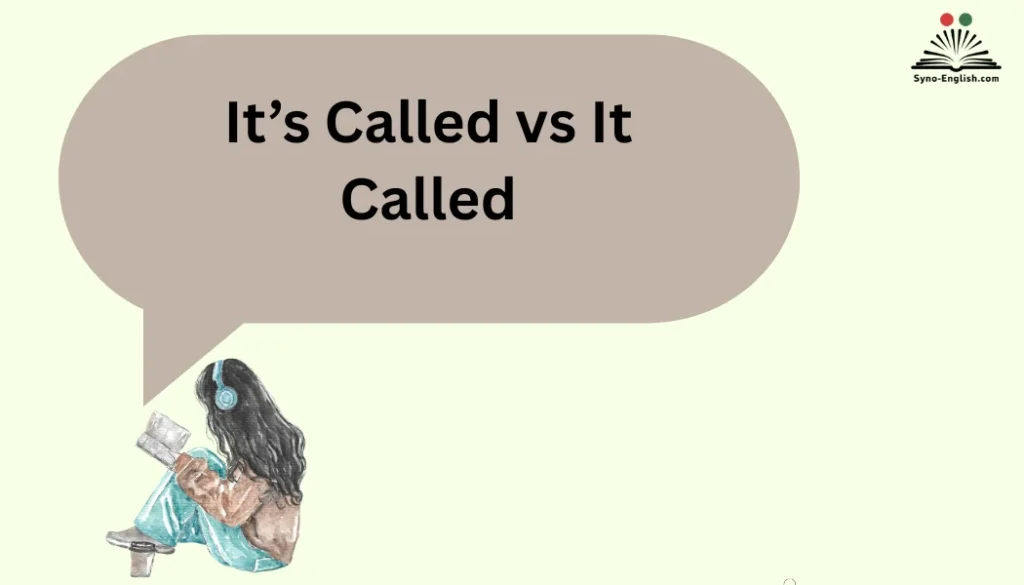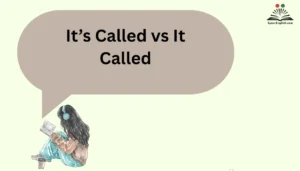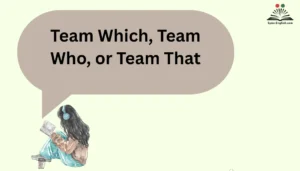It’s Called vs It Called can be tricky to master, but understanding how language evolves constantly helps prevent confusion and ensures clear communication. Even small differences in grammar carry significant implications for meaning. At a glance, knowing when to use the correct form is critical to convey your thoughts precisely.
This guideunpackspracticalexamples that highlight the distinction between “It’s called” and “It called.” Comparing contexts equips you with strategies to avoidmistakes. I often teach students how the choice of words can transform their writing and make lessons memorable. Understanding subject-verb relationships makes these forms intuitive.
The Confusion Between “It’s Called” and “It Called”
Both phrases share the same subject—“it”—but their grammatical structures diverge sharply. Many learners, and even native speakers, misuse these forms interchangeably, which leads to unclear writing.
- “It’s called” means it is named. This contraction is always tied to identifying or labeling something.
- “It called” places “called” as the main verb in the past tense, meaning it performed the action of calling.
Think of the difference like this:
- “It’s called a telescope.” → You’re naming the object.
- “It called for help.” → The subject it carried out the action.
The confusion often comes from skipping over the apostrophe in “It’s” or assuming both forms can be used in naming situations.
Understanding “It’s” – The Contraction Explained
At its core, “It’s” is a contraction, which means two words have been shortened into one. In this case:
- It’s = It is
- It’s = It has
These are the only two correct meanings for “It’s.” Nothing else.
Examples:
- “It’s raining outside” → “It is raining outside.”
- “It’s been a long day” → “It has been a long day.”
In the context of naming, “It’s called” always expands to “It is called.”
Grammar Note: Contractions have been used in English since the Middle Ages. Early English texts already shortened phrases like “ne is” into “nis” (not is). Today, contractions remain a natural part of speech in both spoken and written communication.
When to Use “It’s Called”
You use “It’s called” whenever you’re introducing the name of something. This construction is especially common when explaining new terms or concepts.
Everyday Examples
- “It’s called a GPS device.”
- “It’s called multitasking.”
- “It’s called inflation.”
Educational and Professional Contexts
- Teachers introducing a concept: “This process is called osmosis.”
- Business presentations: “It’s called a value proposition.”
- Scientific explanations: “It’s called renewable energy.”
Rule of Thumb: If you’re naming, labeling, or identifying something, “It’s called” is the correct choice.
Why “It Called” Is Grammatically Different
While “It’s called” is about naming, “It called” is about doing. Here, “called” functions as a verb in the past tense.
Examples:
- “It called for backup when the system crashed.”
- “It called my attention to the missing detail.”
Notice how the subject (it) is actively performing the action.
This structure doesn’t work in naming contexts. For example:
- ❌ Wrong: “It called a smartphone.”
- ✅ Right: “It’s called a smartphone.”
Key Point: “It called” describes an action in the past. “It’s called” describes a state of naming or identity.
Comparing “It’s Called” vs “It Called”
Here’s a quick breakdown:
| Feature | “It’s Called” | “It Called” |
| Meaning | It is named | It performed the act of calling |
| Verb Tense | Present (contraction of is) | Past (simple past of call) |
| Use Case | Naming, labeling, identifying | Describing an action |
| Examples | “It’s called empathy.” | “It called for attention.” |
This comparison table makes the choice crystal clear.
Common Errors and Misconceptions
Even experienced writers sometimes stumble over the apostrophe. Here are the biggest mistakes:
- Mixing “its” and “it’s”:
- “Its” = possessive pronoun (The dog wagged its tail).
- “It’s” = contraction (It’s been a great day).
- Using “It called” instead of “It’s called” when naming.
- Wrong: “It called a dictionary.”
- Right: “It’s called a dictionary.”
- Overusing contractions in very formal documents (like academic papers), where style guides may prefer the full form (It is).
Practical Examples in Sentences
Here’s how both forms work in practice:
Correct Use of “It’s Called”
- “It’s called constructive criticism, and it helps teams improve.”
- “It’s called blockchain, and it underpins cryptocurrency.”
Correct Use of “It Called”
- “It called loudly in the night.”
- “It called for immediate action.”
Incorrect Usage
- ❌ “It called a new app ‘FitTrack’.”
- ✅ “It’s called FitTrack.”
Formal vs Informal Writing: Where Each Fits
In everyday speech and writing, contractions like “It’s” make your tone conversational and natural. However, style matters.
- Formal contexts (academic papers, legal documents, some business reports): Avoid contractions. Instead of “It’s called photosynthesis,” write “It is called photosynthesis.”
- Informal contexts (blogs, emails, dialogue, creative writing): Contractions create warmth and flow.
Case Study:
A university professor would write in a research paper:
- “This process is called anaerobic respiration.”
Meanwhile, in a classroom lecture, the same professor might say:
- “It’s called anaerobic respiration.”
Both are correct—the difference lies in the level of formality.
Easy Memory Tricks to Avoid Confusion
Here are practical tools to prevent mix-ups:
- Expand the contraction: If you can replace “It’s” with “It is” or “It has,” you’re safe.
- Action test: If “it” is actively doing something, use “It called.”
- Read aloud: Spoken flow often reveals whether the phrase makes sense.
- Mnemonic: “It’s = It is or It has. Nothing else.”
Why Getting It Right Matters
At first glance, mixing “It’s called” and “It called” might seem trivial. Yet in professional and educational settings, such mistakes can undermine credibility. Clear grammar ensures your audience understands your meaning.
- In business, correct phrasing reflects professionalism.
- In academics, precision distinguishes serious research from sloppy writing.
- In daily conversation, accuracy prevents misunderstandings.
Quote to Remember:
“Grammar is not just about rules—it’s about clarity and respect for the reader.”
Conclusion
Mastering the subtle difference between “It’s called” and “It called” is essential for clear and effective communication. Language evolves constantly, and small nuances can significantly change the meaning of a sentence. Grammar rules provide the structure needed to convey ideas correctly, and understanding the distinction between these two forms helps prevent confusion. At first glance, the difference seems minor, but the implications for context, tense, and readability are significant.
Through this guide, we unpacked practical examples showing how each form is used. “It’s called” typically serves as a descriptive phrase, whereas “It called” often appears in narrative or past-tense situations. By comparing contexts, learners can develop strategies to avoid common mistakes. Paying attention to the choice of words and the correct subject-verb relationship equips writers to communicate more clearly. Using the exactly appropriate phrase ensures that your sentences remain precise, professional, and easy to understand.
Practicing with various examples makes the rule memorable, and consistently applying it improves writing fluency. Small, careful steps in understanding these phrases can transform written and spoken communication. In the end, mastering “It’s called” versus “It called” is not just a grammar exercise—it’s a tool for effective expression, clarity, and confidence. With focus and regular practice, anyone can make the correct choice naturally and convey ideas without ambiguity.
FAQs
What is the main difference between “It’s called” and “It called”?
“It’s called” is used as a descriptive phrase to explain what something is named, while “It called” usually appears in past-tense or narrative contexts. Understanding the difference depends on tense and subject-verb agreement. Using the correct form avoids confusion and ensures clear communication, maintaining proper grammar and precise meaning in writing or speaking.
Can I use “It called” instead of “It’s called”?
No, they are not interchangeable. “It’s called” describes the name or identity of something in present tense, while “It called” indicates a past action. Replacing one with the other can change the meaning and confuse readers or listeners. Observing the distinction and grammar rules ensures your communication remains clear and professional, and helps avoid mistakes in writing.
How do I remember when to use “It’s called”?
Focus on the context. If you are describing a name, title, or label in present tense, “It’s called” is correct. Using examples in practice makes this memorable, and comparing it to “It called” helps reinforce the difference. Creating a mental checklist of subject-verb relationships and reviewing grammar rules can help avoid confusion and make correct usage intuitive over time.
Is “It called” grammatically correct?
Yes, but only in specific contexts. “It called” typically appears in past-tense sentences, like a story or event. It is incorrect if used to describe a name in present tense, which requires “It’s called.” Understanding the difference is critical for clarity, and observing grammar rules and practical examples helps writers avoid mistakes and maintain clear communication.
Can “It’s called” be used in past tense?
No, “It’s called” is present tense and cannot describe past actions. For past situations, use “It called” or rephrase the sentence. Correct usage ensures clarity and proper grammar, preventing confusion. Observing contexts and comparing examples equips learners with strategies to avoid mistakes, keeping written or spoken communication professional and precise.
Why is the distinction important in writing?
Even small differences in grammar can affect the meaning of a sentence. Using “It’s called” incorrectly or “It called” in the wrong context can create confusion for readers. Understanding the distinction, applying practical examples, and choosing the correct form are critical for clear, professional communication, ensuring your ideas are conveyed accurately and effectively every time.
Are there tips to remember these forms easily?
Yes, focus on tense and subject-verb relationships. Remember that “It’s called” = present description, “It called” = past action. Practice with examples, create memorable sentences, and compare contexts. This equips you with strategies to avoid mistakes and improve clarity. Regularly reviewing grammar rules helps internalize the correct choice of words, making usage intuitive over time.
How does context affect the choice?
Context determines whether a phrase describes a name or an action. Present tense and descriptive situations require “It’s called”, while narrative or past events require “It called.” Observing the difference, using examples, and checking grammar rules ensures clear communication, prevents confusion, and helps writers make the exactly right choice of words.
Can mistakes in these phrases affect readability?
Yes, using “It’s called” or “It called” incorrectly can confuse readers and disrupt sentence flow. Attention to grammar, distinction, and practical examples improves readability. Choosing the correct form makes writing clear, professional, and precise. Applying strategies to avoid mistakes ensures that the meaning is conveyed accurately, enhancing overall communication effectiveness.
What is the easiest way to practice using these phrases?
Use practical examples in writing and speaking exercises. Compare contexts, note differences, and reinforce them to make lessons memorable. Focusing on grammar rules, subject-verb agreement, and exactly correct choice of words equips learners to avoid mistakes. Over time, practicing in short sentences and reviewing examples improves communication, making It’s called vs It called usage intuitive and natural.

Emma Brooke is a passionate English educator, writer, and language enthusiast with over a decade of experience helping learners master the nuances of the English language. At SynoEnglish, she blends practical grammar advice with real-world communication tips to make English easier, clearer, and more enjoyable for readers of all levels.



